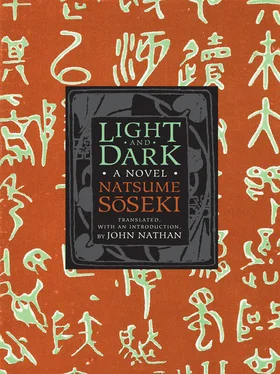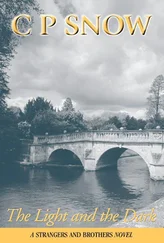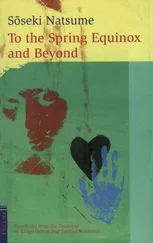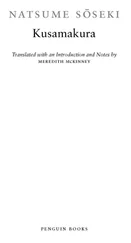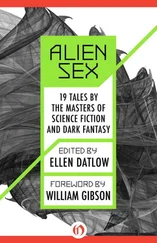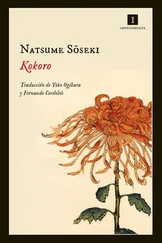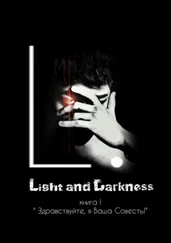There are other extrapolations, but none clarifies or deepens significantly the vision that Sōseki has already conjured: the unlikelihood of an escape from the prison of vanity and self-interest into the light of liberating self-knowledge. Among the writers who have essayed to “conclude” the novel with a full-length sequel — there have been four published attempts 25—only Mizumura Minae has conveyed the pessimism that is Sōseki’s primary color. Her Light and Dark, the Sequel ( Zoku Meian , 1990), begins boldly with the final installment of Light and Dark and develops the game of cat-and-mouse that Sōseki initiated. At moments, Kiyoko appears on the verge of lowering her defenses; she even declares provocatively, “I’m afraid of what will happen if I stay here.” Eventually Tsuda badgers her into divulging an explanation for having turned away from him: “When all is said and done I can’t trust you,” she obliges. “For example, here you are, you came all this way…. I can’t help wondering if I might have been betrayed in this same way if we’d gotten together.” 26Coming from the woman who inhabits his dreams, this unsparing put-down might have withered Tsuda with chagrin, for he is guilty as charged of betraying his wife. But, as always, he is insulated against humiliation by his own self-regard and feels only anger. Just then O-Nobu arrives, but there is no confrontation between the women, only a moment of breathtaking awkwardness. Kiyoko returns to the inn with a soft “Farewell,” and the couple is left alone to suffer in silence. Thus Mizumura’s sequel concludes on a note that seems congruent with Sōseki’s intent: difficult lessons have not been learned, and the way ahead is no clearer than it ever was.
The question remains: Is Light and Dark incomplete as Sōseki left it? Certainly he intended to continue writing, but an author’s desire to augment a novel needn’t be taken ipso facto as proof that the work is unfinished; in view of the inconclusiveness that characterizes much of Japanese fiction, the question may not be as frivolous as it appears. How “complete,” for example, is Snow Country by Kawabata Yasunari, a series of impressionistic episodes loosely assembled over a period of long years, or, for that matter, the same author’s open-ended portrait of an old man preparing for death, The Sound of the Mountain? How complete is Tanizaki Jun’ichirō’s Some Prefer Nettles , which ends with the mistress O-Hisa kneeling enigmatically in the doorway? And what of Tanizaki’s magnum opus, The Makioka Sisters , which leaves the reader with Yukiko, suffering from diarrhea, boarding a train for Tokyo to begin her new life as the wife of an architect who is not introduced?
Let us not belabor the point. Light and Dark appears to be as complete as many Japanese novels in the twentieth-century canon: everything the reader needs to know about its principal characters to anticipate the ineluctable outcome Sōseki intends has been revealed. The details of the ending are missing, but the essence of his conclusion is already encoded in the text: Tsuda will not succeed in liberating himself from the egoism that blinds him, and O-Nobu will continue to pursue an exalted version of love that she will not ultimately attain. This motif is a refrain that sounds throughout Sōseki’s oeuvre. It is the contradictory, terrifying, ultimately unaccountable complexity of human consciousness microscopically examined in Light and Dark that installs it as a landmark in twentieth-century Japanese fiction.
Notes
1. His family name was Natsume; his given name, Kinnosuke. At twenty-two, he chose “Sōseki” (漱石) for a pen name from an ancient Chinese story. The phrase means “to gargle with stones.” In the anecdote, collected in a popular Chinese language primer, a civil servant intending to become a recluse declares, mistakenly inverting a Chinese expression, that he will “pillow his head on the river and gargle with stones.” Corrected, he argues intractably that his mistake was intentional. In taking the name, Sōseki is representing himself as a contrarian. His choice suggests a self-conscious identification with China’s literati.
2. Natsume Sōseki, “The Civilization of Modern-Day Japan,” in Kokoro: A N ovel and S elected E ssays , trans. Edwin McClellan, essays trans. Jay Rubin (Lanham, Md.: Madison Books, 1992), 278
3. Even in his day, Sōseki was hardly light reading. It was the Asahi ’s policy to appeal to less ambitious readers by serializing a second, less demanding novel in parallel with Sōseki’s. Light and Dark shared the pages of the paper with two works by Nakarai Tōsui, a “newspaper novelist” less famous for his writing than as the writing teacher who broke Higuchi Ichiyo’s heart.
4. Sōseki defended his decision to resign his lectureship at the most prestigious university in the country to become a “newspaper man” in a somewhat facetious article, “Statement on Joining the Asahi .” See Natsume Sōseki, Theory of Literature and Other Critical Writings , ed. Michael K. Bourdaghs, Atsuko Ueda, and Joseph A. Murphy (New York: Columbia University Press, 2009), 155–58.
5. Yamamoto Shōgetsu was editor of the literary arts section. See Natsume Sōseki, Sōseki zenshū ( SZ ), 28 vols. (Tokyo: Iwanami Shoten, 2004), 24:532.
6. The tyranny of the daily installment is perceptible in the text. Sōseki went out of his way to end many of the installments with contrived cliff hangers, and others begin with recapitulation. A few strokes in red pencil by an editor may easily have effaced these minor blemishes, but editing a master’s manuscript is considered disrespectful in Japan, and emendation of this kind is outside the translator’s jurisdiction.
7. On February 19, 1916, Sōseki had written the young writer a letter of fulsome praise for his short story “The Nose”: “Create another 20–30 stories of this quality and see what happens — you will find yourself a member of our literary brotherhood without equal” ( SZ 24:510–11). Archived in the Museum of Modern Japanese Literature together with the letter it contained, Sōseki’s envelope has been torn open, as if Akutagawa had been unable to control his impatience to see what the master had written.
8. SZ 24:554–56.
9. SZ 24:558–62.
10. The original manuscript of Light and Dark is in the archives of the Museum of Modern Japanese Literature in Tokyo and may be examined on request in advance.
11. SZ 24:589–90.
12. O-Hide is pronounced O-HE-day.
13. Yoshimoto Takaaki characterized Sōseki’s style in later years as “consciously motivated by his wish to experiment with narrowing the gap between an English prose style and that of Japanese” (quoted in Reikō Abe Auestad, Rereading Sōseki: Three Early Twentieth-Century Japanese Novels [Wiesbaden: Herassowitz, 1998], 149).
14. Sōseki, “Interrelations Between Literary Substances,” in Theory of Literature and Other Critical Writings , 107–11.
15. Henry James, The Art of Criticism , ed. William Veeder and Susan M. Griffin (Chicago: University of Chicago Press, 1986), 288.
16. Ibid.
17. In the margin of page 103 he notes: “This writer’s prose style aims to express things easily understood in language that is hard to understand” ( SZ 27:159).
18. SZ 19:359.
19. SZ 14:239.
20. Madam Yoshikawa suggests that a trip to visit Kiyoko will be “the best possible treatment for O-Nobu” and explains ambiguously, “Just watch, I’ll teach O-Nobu-san how to be a better wife to you, a more wifely wife” (142:311). Some Japanese critics have interpreted this to mean that O-Nobu must be taught, however painfully for her, that her emphasis on the nature of the love she receives from Tsuda is an unseemly attitude for a wife, who should be focused on helping her husband maintain favor with his relatives. See Ōe Kenzaburō, Saigo no shōsetsu (Tokyo: Kōdansha, 1988), 161. Perhaps. Or perhaps she is simply jealous. Or possibly this is just characteristic perversity: “With no limits on her time, [Madam] needed no invitation, given the opportunity, to meddle in the private affairs of others, and she enjoyed looking after people beneath her, particularly those she was fond of, all the while making clear unabashedly that she was acting principally in the interests of her own amusement” (132:289).
Читать дальше
